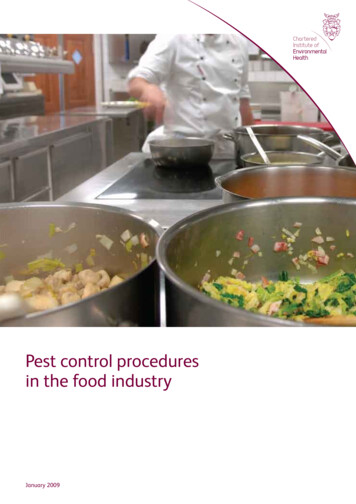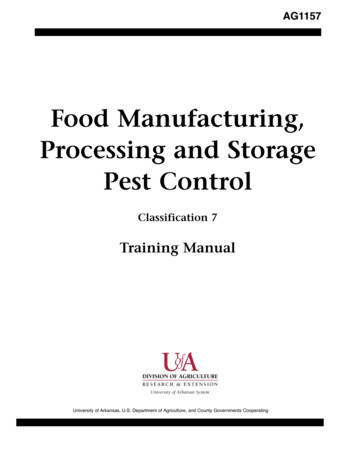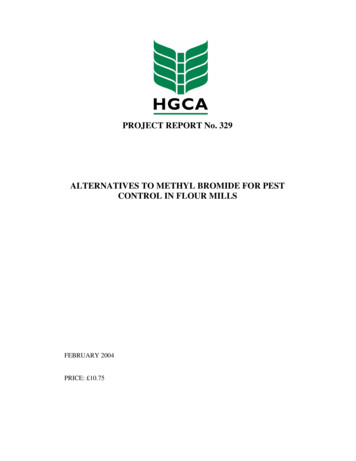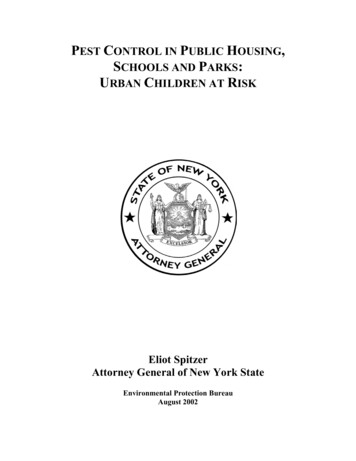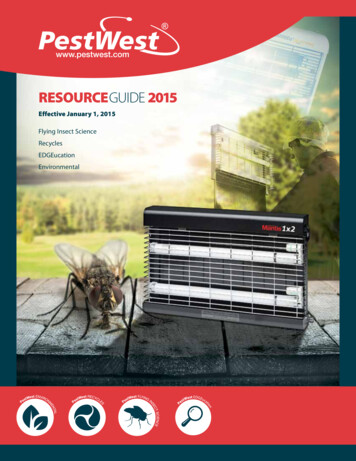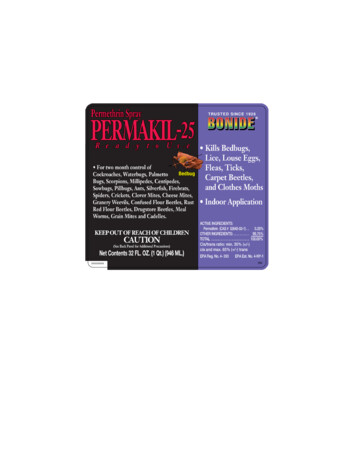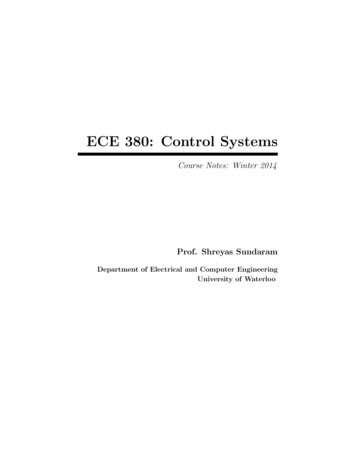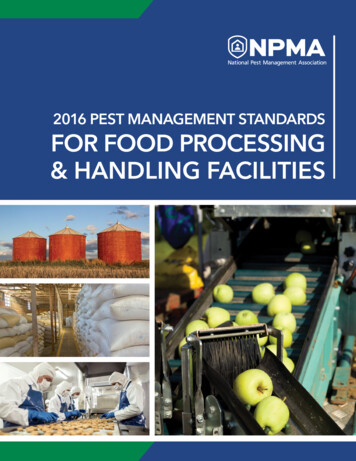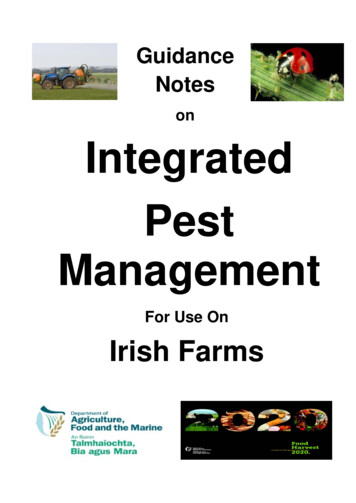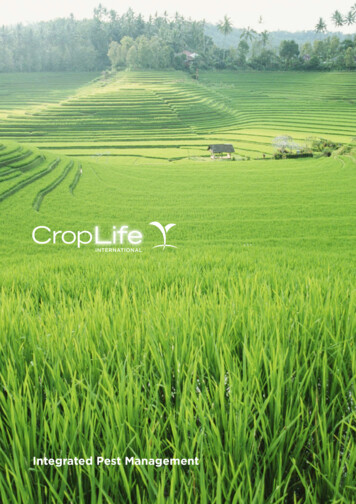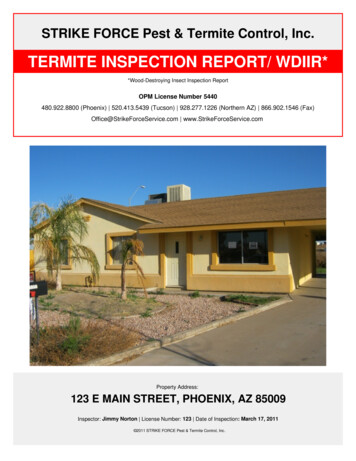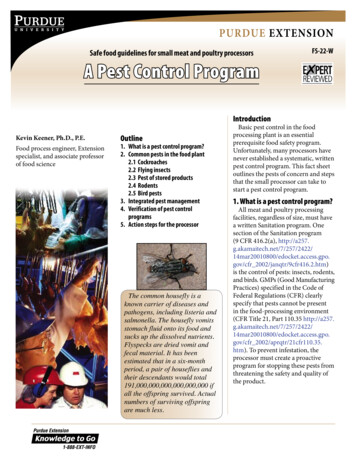
Transcription
PURDUE ExTENSIoNSafe food guidelines for small meat and poultry processorsFS-22-WA Pest Control ProgramIntroductionKevin Keener, Ph.D., P.E.Food process engineer, Extensionspecialist, and associate professorof food scienceOutline1. What is a pest control program?2. Common pests in the food plant2.1 Cockroaches2.2 Flying insects2.3 Pest of stored products2.4 Rodents2.5 Bird pests3. Integrated pest management4. Verification of pest controlprograms5. Action steps for the processorThe common housefly is aknown carrier of diseases andpathogens, including listeria andsalmonella. The housefly vomitsstomach fluid onto its food andsucks up the dissolved nutrients.Flyspecks are dried vomit andfecal material. It has beenestimated that in a six-monthperiod, a pair of houseflies andtheir descendants would total191,000,000,000,000,000,000 ifall the offspring survived. Actualnumbers of surviving offspringare much less.Basic pest control in the foodprocessing plant is an essentialprerequisite food safety program.Unfortunately, many processors havenever established a systematic, writtenpest control program. This fact sheetoutlines the pests of concern and stepsthat the small processor can take tostart a pest control program.1. What is a pest control program?All meat and poultry processingfacilities, regardless of size, must havea written Sanitation program. Onesection of the Sanitation program(9 CFR 416.2(a), 800/edocket.access.gpo.gov/cfr 2002/janqtr/9cfr416.2.htm)is the control of pests: insects, rodents,and birds. GMPs (Good ManufacturingPractices) specified in the Code ofFederal Regulations (CFR) clearlyspecify that pests cannot be presentin the food-processing environment(CFR Title 21, Part 110.35 800/edocket.access.gpo.gov/cfr 2002/aprqtr/21cfr110.35.htm). To prevent infestation, theprocessor must create a proactiveprogram for stopping these pests fromthreatening the safety and quality ofthe product.
A Pest Control Program (FS-22-W)Table 1. To create a plan or contract with an outside pest controller?Processor-supported programContracted programUpfront costLower, usuallyHigherProcessor time commitmentHighVirtually nonePest control expertiseLow, usuallyHighRecordkeepingProcessor supportedContractor supportedEquipment and chemicalsProcessor must obtainContractor suppliesValidation materialsProcessor obtainsContractor suppliesOverall benefitsMust be evaluated by the processor, taking into account all the factorsnecessary to develop and maintain the programThe pest control program is a stand-alone programand is also a part of the plant’s food safety system. Mostsmall food plants must decide whether to maintain apest control program themselves or contract theprogram to a pest control company. There are positiveand negative aspects of each approach. Table 1 listssome things to consider.The pest control program is considered aprerequisite program. It is necessary for aplant to implement a pest control programto prevent adulteration of product. It is anecessary part of the total plant foodsafety program.Many small processing facilities hire a pest controlcompany because the processor lacks the personneland expertise to run such a program. Of course, a pestcontrol contractor should be reputable and haveproper training and experience. A pest controlcontractor must provide records and reports to theprocessor verifying that the program is effective andoperating successfully. This verification is usuallydone through visual inspection for pests and/orevidence of pests in the plant or product. Theprocessor must maintain these records with the plant’shazard analysis records to prove that the contractedpest control program is effective. The verificationrecords should include evidence of contractor trainingand certification to apply pesticides in a foodmanufacturing environment, and evidence that thepesticides are approved for such use.Items included in a pest control program1. Pest control procedures — The activitiesperformed to control each type of pest. The writtenprocedures should be detailed and includefrequency of action.2. Recordkeeping — The documentation of eachperformed activity. These records must be accurate,up-to-date, and include inspection for evidence ofpests in each plant area.3. Responsible individuals — The person(s) who arecharged with performing pest control proceduresand recordkeeping. Also, the supervisor responsiblefor signing off on reviewed records.4. Deviation — Evidence of a pest problem is asubjective determination that requires expertise. Forexample, periodically finding a cockroach under atrashcan may be acceptable, but finding manycockroaches would be a deviation. A deviation hasoccurred when an allowable limit has been exceeded.5. Corrective measures — These are written actionsteps in the plan that will be performed if there is adeviation from the pest control program. Often,they may include increasing control procedures,retraining of employees, cleaning up the area, etc.Many processors choose to develop and maintaina pest control program themselves. An effectiveprogram can be developed in-house if the processorunderstands how to control pests. The program wouldconsist of several written sections.Purdue’s Department of Entomology offers sixself-study, online courses in pest ia/pest/),including one on pest management in food plants.2
A Pest Control Program (FS-22-W)6. Verification and validation — Written scientificevidence that the procedures are effective atcontrolling pests. This material is often availablefrom chemical, trap, and pest control equipmentmakers. Also, verification is documentation ofvisual inspection for evidence of pests.harbor the insects or their eggs cases). This is done bysealing and filling cracks and crevices and maintaininga sealed, smooth surface throughout the plant inproduction and nonproduction areas. Seal junctionboxes, receptacles, and control panels. Seal openingsaround conduits and pipes where they pass throughwalls and ceilings. Inspect incoming shipments(packaging, ingredients, etc.) and reject infestedshipments. Chemical control requires that EPApermitted insecticides be used in the food plant. Theseproducts are generally formulated as sprays, aerosols,or dusts. Dry powders and dusts, such as boric acid andinsecticide powders, take advantage of the cockroaches’habit of preening themselves. It is important tounderstand that no pesticide can be used in a foodprocessing plant unless EPA has approved such use.2. Common pests in theprocessing plant and ways to control them2.1 CockroachesThere is no insect, other than the housefly, that ismore easily recognized and detested than the cockroach.Cockroaches have been shown to transmit diseasesincluding pathogenic foodborne bacteria such assalmonella, Vibrio cholerae, Staphylococcus aureus, andothers both in the insect’s gut and on its exterior surface.2.2 Flying insectsThe most common flying insects are the houseflyand fruit fly. A single housefly has been estimated tocarry up to 3.6 million bacteria. Flies transmit diseaseby spending part of their life in direct contact with orin close contact to fecal matter or decaying material.Flies must liquefy their food before ingestion, so theysecrete salvia (often called vomitus) on surfaces. Themovement of flies from unwholesome food sources tofresh food products, processing equipment, and othersurfaces provides many opportunities to transmitdisease-causing bacteria.Removal and elimination of breeding sites is a keyto fly control. This primarily involves the availability ofgarbage. Garbage must be located away from doors andremoved frequently, and waste disposal areas must beproperly maintained. Next, flies must be excluded fromentering the food processing facility. This includesusing air curtains (air screens) and/or doors that closeautomatically.Detection: Each species has specific habitatpreferences, although any species could be found in afood plant building. A good way to detect cockroachesis to enter a darkened production or storage area, turnon the lights, and quickly look for roaches scurryingback into hiding. Cockroaches also may be found byinspecting inside electrical junction boxes, receptacles,and control panels, or by looking behind objects and infloor drains. Glue traps often are a good monitoringdevice; some come equipped with a pheromoneattractant. The use of flushing gases (a number ofpyrethroid aerosol products are very good for thispurpose) is a common method of driving them out inthe open. These materials are so highly repellant that asingle squirt into a suspect crack or crevice can causethe roaches to come boiling out into the light. Also, lookfor droppings and egg cases that indicate their presence.Electrocution traps with blue fluorescent light trapsare effective in reducing flying insects, including flies.One drawback to these electrocution traps is that theyliterally cause the fly to explode, throwing aerosolizedfly matter into the air. Because those particles can driftdown some distance from the trap, it is best to placethese traps away from food-handling areas, or wellremoved from food-handling surfaces in those areas.Blue-lighted sticky traps, baited jug traps and strips, orsticky ribbons are a safer alternative in these areas.Dead flies should be removed from traps at regularControl of cockroaches starts with elimination ofharborage (especially cardboard boxes that could3
A Pest Control Program (FS-22-W)intervals. Catch basins of electrocution traps or jugtraps and strips should be cleaned daily. Sticky devicesshould be replaced at least once a week. Othercommercial methods utilize insecticidal sprays or fogsto suppress flies, but exclusion should be the main lineof defense.Regular cleaning of storage areas and processingequipment to remove ingredient spills and accumulateddust is also important. Fumigation of empty storagebins with phosphine, ethylene oxide, or carbonylsulfide are effective control options for stored productpests. Similarly, fumigation may be used in facilitieswhen processing operations are over for the day.2.4 RodentsRodents include rats and mice. They must becontrolled in and around a food plant because rats andmice carry and transmit disease, and they can causesignificant economic losses by damaging foodcontainers, contaminating food with rodent droppings,and consuming food. Two major species of rats arefound in and around human habitation: the Norway ratand the roof rat. The common mouse species prevalentaround human population in the U.S. is the housemouse.Both rats and mice reproduce rapidly, rats having 20offspring per year and mice up to 35 young per year.Both mammals are primarily nocturnal, but they leavebehind several signs of infestation.Air curtains prevent flying insects from entering theprocessing building through receiving, shipping, oremployee entrances. Photos courtesy of Mars Air Doors(Gardena, Calif.).Signs of rodents1. Droppings — Fecal matter is a sign of rodentpresence, and the amount of it can indicate theextent of the infestation.2. Visual sightings — Seeing rats or mice oftenindicates a serious and probably well-establishedinfestation, but most experts believe that visualsightings are the least reliable indicators.3. Noises — Shrill squeaks, gnawing sounds, andscurrying sounds could be caused by rodents.4. Smudge marks — Rodents emit oily lipid materialfrom their fur and leave greasy smudges at entrypoints and frequent travel paths. Rat smudge marksare often more noticeable than those left by mice.5. Tracks — Coating the area around suspected entrypoints and travel ways with talc, chalk, or flour candetect tracks and tail marks to identify locations forbait station or trap placement.6. Gnawing — Both rats and mice chew and gnawmaterials, which is a sure sign of rodent presence.Rats and mice are known to gnaw the insulation ofelectrical wires, causing fire hazards. Mice are knownto cause extensive damage to insulation materials.2.3 Pests of stored productsThese primarily include insects that use the food asboth nourishment and a habitat. They are usually smallinsects that infest and destroy foods during all stages oftheir life cycles. This group includes beetles, weevils,borers, and moths. Stored product pests are notgenerally associated with disease, as are cockroachesand flies, but they are considered a major foodcontaminant. As a group, they prefer dry products suchas cereal grains and flours, but other foods such as nutsand dried fruits may be infested, as well.Weevils infest stored grain and cause economic lossesworldwide. The life cycle for most weevils is four to fivemonths, and they can infest nearly every cereal grain.Flour moths lay their eggs in flour or meal where thelarva destroys the product, and they are importantgrain pests. A variety of beetles can infest foods andfood ingredients. These include grain beetles, flourbeetles, and others.Prevention: The purchase of quality, pest-free grainand food ingredients is the first step to prevention.4
A Pest Control Program (FS-22-W)administered in bait blocks, liquid baits, pelletizedbaits, or treated grain.Toxic tracking powdersTracking powders are designed to kill the rodentswhen they groom themselves. These powders areplaced along rodent travel ways or in burrows.TrappingTraps are a safe and effective method of eradication,especially for mice and roof rats. Rodents, especiallyrats, can become trap shy. Glue traps can also effective,and they may trap roaches as well.Ultrasonic devicesThere is controversy about the effectiveness of usingultrasounds (above 30,000 Hz) to repel rodents. Somedevices alter the wavelength and direction of sound,and most are somewhat effective when placed atopenings to food plants. Most rodents become used toultrasonic devices after exposure.7. Urine stains — Both rats and mice leave u
The pest control program is a stand-alone program and is also a part of the plant’s food safety system. Most . small food plants must decide whether to maintain a pest control program themselves or contract the program to a pest control company. There are positive and negative aspects of each approach. Table 1 lists some things to consider. Many small processing facilities hire a pest .
